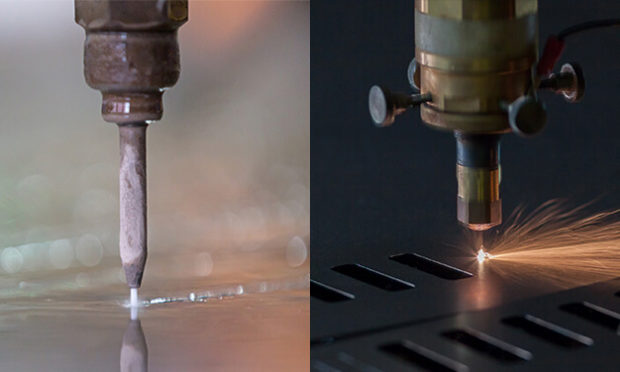In the world of cutting, two types of cutters make the cut. The waterjet cutter and the laser cutter. However, not many know which they should use for a specific task.
In this article, we’ll get into the specifics of the two cutters.

-
Laser Cutting
Laser cutting involves the use of a gas such as carbon dioxide (CO2) which provides the energy required to cut through components. The gas is then channeled through a beam courtesy of a number of mirrors. In this case, the laser source is buried deep in the machine and can produce anything from 1500 to 1600 watts.
Applications and Materials
You can use laser cutters to cut through several materials such as wood, metals, glass and plastic. Nevertheless, it can be difficult to cut through materials which have varying melting points.
In addition, CO2 laser cutters cannot cut sandwiched structures which contain hollow spaces. The same goes for 3D materials since 3D cutting requires agility and flexibility which laser cutting doesn’t possess.
For the thickness, laser cutters work well with materials of 0.12 to 0.4 inches in thickness. Furthermore, laser cutters can be used in structuring, ablation, drilling, welding, cutting and engraving.
Safety and Precision
Precision cutting is achievable when using a laser with up to 0.006” in cutting a slit. Although, this will depend on the laser’s speed.
Also, thin materials may suffer gas pressure damage should you fail to maintain a proper distance. In addition, due to the intense thermal stress, materials may suffer deformation and other minor structural changes.
While working with lasers, it’s important to wear safety goggles and a mask to protect your eyes and lungs from the dust, smoke and debris which may be produced as a result of the cutting.
-
Waterjet Cutting
Instead of using a beam to cut through materials, waterjet cutters use high-pressure water for the same purpose. However, high precision cutting is a challenge, but this can be improved by adding abrasives such as aluminum oxide and other waterjet garnet supplies.
In details, the cutter contains a pump which generates the high-pressure water driven through tough hoses. The pressure is so high and can output at least 4 to 7 kilowatts.
The other difference is that in a waterjet cutter, the pump and the work area are separate. This is different from a laser cutter which has its laser source inside the machine.
Applications and Materials
Unlike lasers, waterjet cutters can slice through almost any material including a combination of materials. However, this cutting procedure exposes the material to delamination.
Nevertheless, this cutter can cut 3D materials, but can only work to a certain extent when cutting sandwiched structures.
Similar to laser cutters, waterjets can also be used in structuring, ablation and cutting, especially with ceramics, thick metals and stone. Moreover, waterjet cutters can cut materials up to 2.0” in thickness.
Safety and Precision
As mentioned, waterjets aren’t as precise as laser cutters. The former can only cut a minimum .02” in size slit. When it comes to safety, you must use safety equipment since parts may fly off due to the immense force applied to the material.
In addition, abrasives added to the water may pose a danger to the operator. Therefore, it’s vital to wear goggles. The noise can also be a nuisance and earmuffs can come in handy.
Laser cutters and waterjet cutters may share several similarities such as those in their applications, but there’re a host of differences which you must keep in mind when choosing a cutter for a specific job. With the information in this article, you should be able to choose a suitable cutter.



